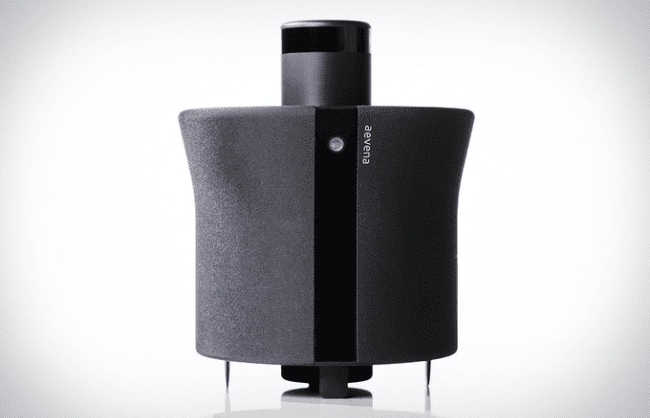Aire Self-Flying Robot

I’ve seen a lot of advancements in the field of robotics. It’s a field that continues to grow with countless advancements and ideas, but not all of them are liable to stick. That’s why I think it’s important to take a deep look at any idea presented, and see just why they would work or wouldn’t make it.
Imagine with just a simple voice command like, “Hey, Alexa – ask Aire to take a picture,” you activate a self-flying robot to lift off from its charging dock, hover above your family, and capture a 360-panorama HD-quality aerial shot all from the comforts of your living room. The same robot can send a live streaming 4K video of each floor in your apartment while you’re away on vacation. It honestly just sounds too good to be true to me.
Introducing Aire by Aevena Robotics – what was promised to be a cutting-edge autonomous flying assistant designed to navigate around your home safely. Another Kickstarter with all the prom
ises and yet what was the real goal?
Aire Self-Flying Robot Features
The promise of the Aire was a machine capable of autonomous flight, voice-prompted commands, anomaly detection, and real-time security alerts. The Aire self-flying robot had been planned to seamlessly navigate every room in your home without bumping into your expensive wall art.
The company also promised to arm it with state-of-the-art flight navigation, patented-noise reduction technology, 360-degree panoramic photo capabilities, Amazon Alexa integration, and programmable IFTTT. The Aire would have been a highly versatile robot that used the latest in machine technology to become even more sophisticated with periodic cloud-based firmware updates.
The In-Home Navigation Technology
Aevena Robotics certainly took its time designing Aire. They dedicated 2.5 years of engineering time and $3 million in funds before unveiling its prototype on Kickstarter. The reason behind the three years in development is that it’s tough to integrate top-of-the-line sensor technology specifically for in-home obstacle avoidance.
The solution was incorporating similar technology seen in self-driving cars. The end result was a flying robot with Autonomous Navigation Vision-based Simultaneous Localization and Mapping (USLAM) technology. With an actual prototype to unveil, they had a leg up against most kickstarters that have nothing but promises and no physical product to back them up.
The Personal Home Robotics Platform
The list of features is rather impressive and the company had promised to grow them over time with cloud-based firmware updates. Whether it’s the ducted fan propulsion system, the multi-cam visual odometry, the WhiteNoise frequency sleeping, or the option for multiple dock landings, Aire is an action-packed flying robot that planned to seamlessly integrates into the home.
From remote flight patterns to capturing high-quality HD photo/4K video content, the intuitive platform is designed to empower the operator. Though, that’s all if you can ever get your hands on one.
The Aire Intuitive App
Aevena’s iOS/Android-based app was designed to seamlessly integrate with IFTTT smart home devices. It was fully compatible with Amazon Alexa and perpetual skill upgrades via its developer API, Aire gets more and more sophisticated over time.
If you need a quick home security check, you would be able to instantly monitor the activity by opening up the Aire app. The home security options included alert investigation, live monitoring, virtual visits and, anomaly alerts.
Just imagine being at a restaurant, realizing you might have left the burner on, and being able to send Aire to the kitchen to see if you turned off the stove. It sounds great, yet it all comes down to what you can get in your hands as opposed to what you are told.
IFTTT Integration
The IFTTT integration is quite an interesting idea to look further into. In its anomaly detection mode, for example, you would be able to program Aire to send live streaming 360-degree video to your smartphone while activating your home alarm system. While navigating through your house during a regularly scheduled security sweep, Aire would be capable of sensing whether or not a room is dark and activating the Phillips Hue lights.
If the temperature dips to below freezing while you’re on vacation, Aire would speak to your Nest Thermostat and make sure your pipes don’t freeze.
Development Potential
The automatic over-the-air updates via Aevena’s cloud-based platform would allow for the flying robot to “keep up with the times” – so to speak. From improved virtual home mapping to precision security patrols, Aire’s impressive flight technology was planned to be improved with consistent firmware updates.
Designed around safety inside the home, Aire has been designed with cutting-edge LED ring light technology, an auto-ducking take-off feature, 360-degree obstacle avoidance, multi-dock landing stations, and Whispertech Quiet Flight Technology.
Final Thoughts
As I said, advancements in the field of machines and how they can be incorporated into the homes of everyday people are leading to an expanding product field. However, if it’s hard to get one of those products in your hands then it doesn’t matter how good it would be.
If you can ever get your hands on an Aire Self-Flying Robot that makes good on all the promises then you have yourself a wonder machine, but that’s hard to do. Kickstarters are always a minefield, and even when a product does eventually get delivered it’s rarely in the exact state that was initially promised. The more advanced it sounds, the less likely it will be delivered in the exact manner you want it to.
I would be happy for Aire to go against this mold entirely though. The potential for a machine like this is near limitless.
- DFS Ultra with Music Mode
- Direct Audio Streaming
- ReSound Wireless Accessories
- Speech Focus
- Needs Accessory for Android Connectivity
- Kickstarter Risks
- Difficult to Aquire



